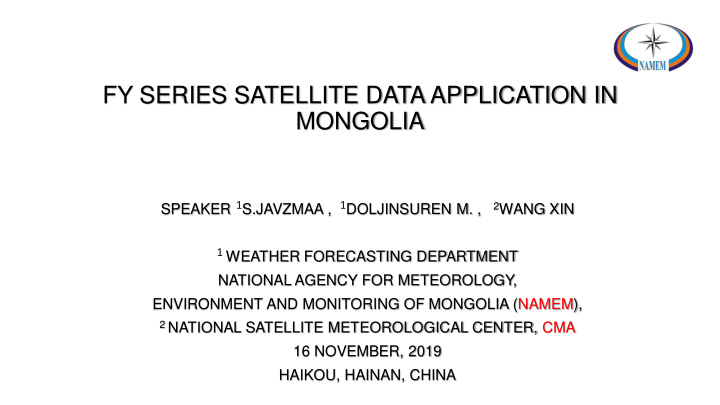



FY SERIES SATELLITE DATA APPLICATION IN MONGOLIA SPEAKER 1 S.JAVZMAA , 1 DOLJINSUREN M. , 2 WANG XIN 1 WEATHER FORECASTING DEPARTMENT NATIONAL AGENCY FOR METEOROLOGY, ENVIRONMENT AND MONITORING OF MONGOLIA (NAMEM), 2 NATIONAL SATELLITE METEOROLOGICAL CENTER, CMA 16 NOVEMBER, 2019 HAIKOU, HAINAN, CHINA
Contents • Overview • Training And Installation Of SWAP Platform In Mongolia And Sharing Data • FY-4A Meteorological Satellite Products Application - Case-1 (Dust Transportation) • FY-2 Series Satellites Application In Assessment And Monitoring - Case – 2 (Convective Event) • Satellite Products Comparison Between FY-2 And FY-4A • Summary
General Information Country name: Mongolia Population: 3.3 million (as estimated in 2019) Capital: Ulaanbaatar Area: 1.56 million sq kilometer Language: Mongolian Currency: Tugrik (MNT) Religion: Buddhist (92%), Muslim (4%), others (4%) Mongolia is an extreme continental climate with long, cold winters and short hot summers. The average summer temperature is +20C (max +44 C). Winter is – 20 C (min -56 C). The average rainfall is 200-220 mm.
Overview FY series meteorological satellites are playing an important role in weather forecasts, climate predictions, environment and natural disaster monitoring etc., They have been widely used in agriculture, forest, water resource, civil aviation and environment protection as a model for satellite applications. The satellite data which have been broadcasted through the CMAcast system in Mongolia is helpful for government decision making, disaster prevention, preparedness and mitigation as well as services in response to global climate change. Since we started receiving FY series satellite data, those have been used for different purposes such as cloud tracking, agriculture and climate change monitoring.
Data Receiving System And Milestones of FY Satellites Year Satellite Resolution Temporal (m) resolution (min) May/2007 FY-2C 1000 30 Feb/2009 FY-2D/G/E 1000 30 Late FY-4A 500 15 Sep/2019
SATELLITE WEATHER APPLICATION PLATFORM (SWAP2) TRAINING AND INSTALLATION IN MONGOLIA, 18 TH SEPTEMBER, 2019
FY-4A Meteorological Satellite Products Application Satellite imagery is a powerful tool for quickly assessing the current weather situation over large areas at any time of day. We can diagnose synoptic- scale weather patterns, track the growth of individual convective storms, differentiate high clouds from low ones or ice clouds from liquid ones, and distinguish between low clouds, snow, dust, land and water surfaces using FY-4A satellite products. However, there are many different applications, i have chosen one of the products that is showing the dust transportation over Mongolia on recent weather event.
Case-1. Dust Transportation Over Mongolia (2019.10.27) Region I FY-2H FY-4A Region II
FY-4A L2: Dust Identification Products
Severe Weather Information And Wind Speed Those Recorded At Meteorological Stations Between 26 th And 27 th of October, 2019.
Other Applications FY-4A Frontal analysis using Airmass image
Other Applications FY-4A Clouds and other feature identifications at various RGB products Day Microphysics
FY-2 SERIES SATELLITE APPLICATION IN ASSESSMENT AND MONITORING FY-2 satellites were used mapping 10 days average temperature and total precipitation over Mongolia since 2007. Because our country’s economy highly depended upon animal husbandry, therefore such information provides wide view over large territory. Moreover, it is mainly used to assess grassland cover that relates to drought condition while snow cover which is needed to monitor the severity of dzud condition.
FY-2 Applications
FY-2 applications Rainfall maps based on the satellite derived cloud duration as well as precipitation recorded at meteorological stations.
Case-2. Convective Event (2019.08.04) One of the most severe weather type during summer season in Mongolia relates to convective event which cause heavy rainfall in immensely short duration. Such convective event forecast is important for city area in order to prevent obvious damages to infrastructure such as road, buildings and power plants etc., The case we chosen here showed that heavy rainfall event on 4 th August, 2019 in capital city of Mongolia, and the rainfall amount was recorded between 14.0 mm and 28.0 mm within less than 2 hours.
FY-2G And Radar Reflection Comparison
Day convective storms RGB product of FY-4A
Product Comparison Between FY-2 And FY-A4 FY-4A Single channel and RGB products and imagery FY-2G products including VIS and IR imagery
Summary • Previous generation FY-2 series satellites provide few channel images. We were used common channels such as VIS, IR and WV for FY-2 series, however it was useful. • FY-4A enables and opens more opportunity as it has multi advanced spectral instruments that have overall 14 channels. There are many comparisons can be made between the products that enhance forecast skills. • Advantages of FY-4A is firstly improved thoroughly, secondly it is open for everyone who wants to track the atmospheric condition with Web based version and finally multi-spectral high resolution channels can be used to study not only earth’s atmosphere but environment and climate change studies. Special thanks to CMA, WMO and Hainan university for their great and kind assist.
Comment As I aforementioned, one of the severe condition which can be occur during summer in Mongolia is that “Convective” related events. Therefore, in terms of improving our weather forecast in short range, we would like to use more accurate convective cloud products generated by FY-4A for early warning from possible disaster including flash flood, hail and lightning.
THANK YOU FOR YOUR ATTENTION!
Recommend
More recommend